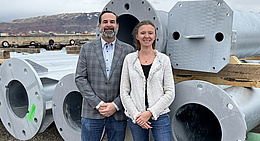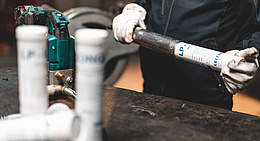Photo: J. NEJEZ
ENVIRONMENTAL PROTECTION
Is energy autonomy feasible for ropeways?
ENERGY SUPPLY At the 2023 Conference of Austrian Ropeway Operators in Innsbruck, an excellent presentation was given on the efforts being made by the country’s ropeways to boost the production of renewable energy.
In the five decades or so that I have witnessed developments in the ropeway industry as technical editor of ISR, there have been significant changes in the attitudes to environmental protection on the part of the operating companies (and society in general). The 1970s and 1980s were decades of strong growth, and environmental and energy issues were largely ignored. When environmental protection became an increasingly urgent topic, ropeway operators were initially able to claim that, with their electric drives, ropeways were one of the cleanest means of transport. For some fanatical environmentalists, this was not enough. One is sometimes tempted to think they would only be happy with mountains that remain deserted. For the ropeway industry, such a notion is obviously absurd, but the realization that the preservation of an intact natural environment is an essential ingredient of tourism increasingly gained ground – and was successfully taken up by the marketing experts.
Environmental protection ideas took on a new dimension with the growing conviction in society that the climate crisis was one of the greatest threats to the future of the planet. CO2 emissions resulting from the use of fossil fuels were identified as the most important driver of global warming. As a result, much greater importance was attached to the issue of renewable energy than before. The exorbitant increase in energy costs two years ago as a result of the war in Ukraine put an even greater focus on renewables.
Renewable energy generation systems are nothing new in the ropeway industry, but only very limited use was made of them in the past, for example in the form of photovoltaic installations on the roofs and façades of ropeway stations.
Today we are witnessing a significant increase in the installation of such systems: The following report on an excellent presentation made at the 2023 Conference of Austrian Ropeway Operators in Innsbruck describes the efforts being made by the country’s ropeways to dramatically increase the production of renewable energy.
Energy autonomy for ropeways – vision or reality?
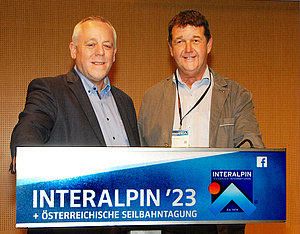
(Photo: J. NEJEZ)
Relatively little was heard on technical issues at the Conferences of Austrian Ropeway Operators in recent years, but this changed at the 2023 event in response to the current energy situation and the pressing issues of environmental protection. In a workshop on the subject of Energy autonomy for ropeways – vision or reality?, the speakers Christian Felder, Chairman of the Federal Technical Committee of the Austrian Ropeway Association, and Wilhelm Mareiler, Operations and Technical Manager of Bergbahnen Kühtai GmbH & Co KG, presented a very full overview of the general energy situation in Europe and the consequences and resulting opportunities for the ropeway industry.
Power generation in Europe
The main energy sources for power generation:
· fossil fuels (coal, natural gas, oil),
· nuclear energy (main source of energy for power generation in France, Sweden and Finland),
· renewables (wind energy, solar energy, hydropower and biomass), and
· imports (electricity from other countries, preferably those with attractive prices).
The trend in recent years, which is expected to continue into the future, has been away from fossil fuels and toward renewable energy sources, thus reducing greenhouse gas emissions at the same time. In addition, increasing efforts are being made to reduce energy consumption through improved energy efficiency.
Power generation in Austria
The most important energy source for generating electricity in Austria is hydropower, which accounts for about 60% of the total. Wind power currently accounts for about 4%, photovoltaics for only 1%, fossil fuels for about 10%, and other energy sources and imports for the rest.
Electricity must not only be generated but also distributed. The power grid has three voltage levels: high, medium and low voltage. The expansion of renewable energies and the integration of decentralized energy sources also call for continuous expansion of the power grid. However, the construction of high-capacity lines in the high-voltage grid especially is meeting with strong resistance from the public.
What are the components in the price of electricity?
The retail price is a combination of three main components:
· procurement costs (generation, transport, distribution, trading prices on the electricity exchanges),
· grid charges (to cover the cost of building, operating and maintaining the grids),
· taxes and levies (electricity tax, sales tax, levy pursuant to the Renewable Energy Sources Act).
The main determinant in the price of electricity, however, is the situation on the European spot markets in terms of supply and demand. These spot markets are auction-based and as such a direct reflection of current demand. A key factor in determining the price is the merit order principle, meaning that all producers receive the same price (€/MWh) for the same product, i.e. electricity, calculated on the basis of the marginal costs of the producers (highest generation costs of a power plant). This – widely criticized – principle means handsome profits for suppliers with low generation costs, with the consumer literally picking up the tab.
Fields of action in energy management
Following a general discussion of the electricity market, the speakers addressed the opportunities available to ropeway operators to respond to the critical cost situation in the energy sector and identified four main fields of action in the context of energy management:
· reductions in energy consumption (maximizing energy efficiency, reducing non-useful operations),
· autonomous energy production (energy recovery, generation through hydropower, photovoltaics, wind power, etc.),
· cheaper procurement (optimized purchasing, peak load management), and
· employment of energy efficiency measures as a marketing tool (communication of achieved energy savings to the public).
Energy consumption in the ropeway industry
Serious planning presupposes reliable data on energy consumption in the various fields of ski area operation. Taking all aspects of ski area operation into account, i.e. infrastructure, catering, heating, piste management, snowmaking and ropeways, total daily electricity consumption per skier comes to 18.0 kWh (see chart).
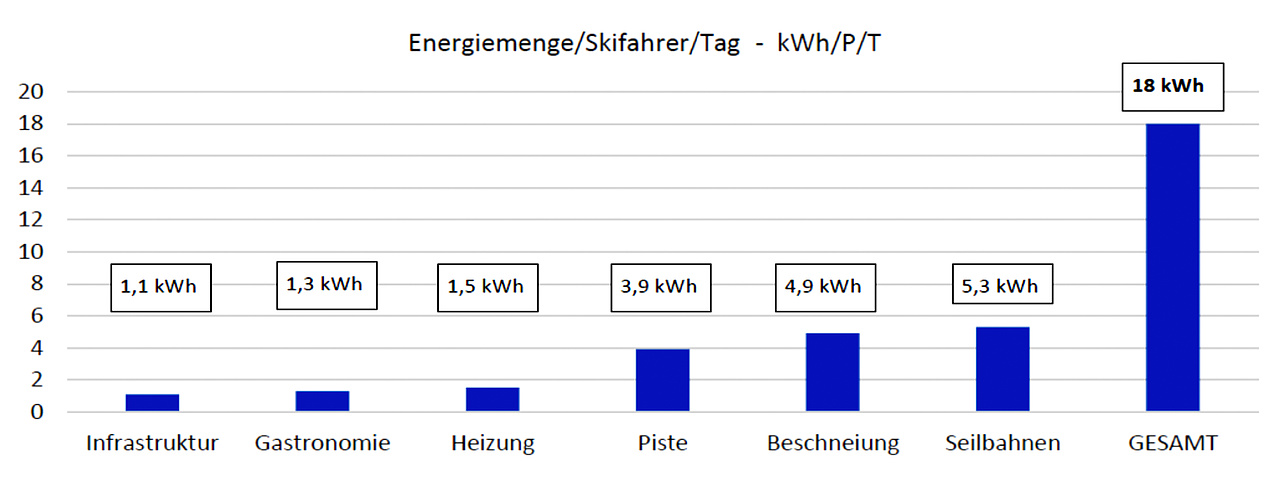
(Source: Austrian Chamber of Trade and Industry, Ropeway Section)
Power generation in the mountains
Following this discussion of the basics of the energy situation in the ropeway industry, the speakers turned their attention to the options available to ropeway operating companies for generating electricity in the mountains as a step in the direction of greater self-sufficiency. They focussed in particular on
· hydropower,
· wind power, and
· photovoltaics.
The truism “It is easier said than done” applies to all three options. Above all, the question of storage of the electricity produced is always a challenge, as none of the methods support the generation of electricity on a continuous basis. Only pumped storage hydropower plants offer large-scale storage of the energy produced, although other storage options, such as battery systems and the conversion of surplus electricity into hydrogen, are available for specific fields of application.
Hydropower
Apart from the small power plants that have long been operated by ropeways with nearby streams or a suitable head of water, the storage ponds that were originally built to supply snowmaking installations can now increasingly be used to generate electricity or operate pumped storage plants. Today’s snowmaking ponds typically have an energy storage potential of between 60 and 85 GWh. The costs and thus the economic feasibility of such plants vary greatly depending on the local conditions, but as a basic principle it can be said, “The larger the better.”
Wind power
The speakers devoted a lot of attention to the subject of wind turbines. Here again, the bigger they are, the more efficient and economically viable they are to operate. In more detail, the following reference values apply:
· For every meter of turbine height above ground, energy output increases by 1%.
· Doubling the length of the turbine blades delivers a fourfold increase in output.
· Twice the wind speed gives an eightfold increase in output.
A number of wind turbines already operating show that wind power in the mountains has considerable potential for the production of renewable energy. However, the installation of wind turbines in difficult terrain can be a challenging business, including transportation to the site of such components as the long turbine blades, which are manufactured in one piece.
Building a wind power plant is a year-long process. The preparatory phase alone involves several steps:
· site-specific wind speed measurements,
· transportation assessment,
· assessment of grid connection and infrastructure requirements, and
· approvals procedures.
In Tyrol a promising wind power project has been drawn up for two sites on the Patscherkofel overlooking Innsbruck. Following clarification of the final details, implementation of the project will simply be a matter of political will!
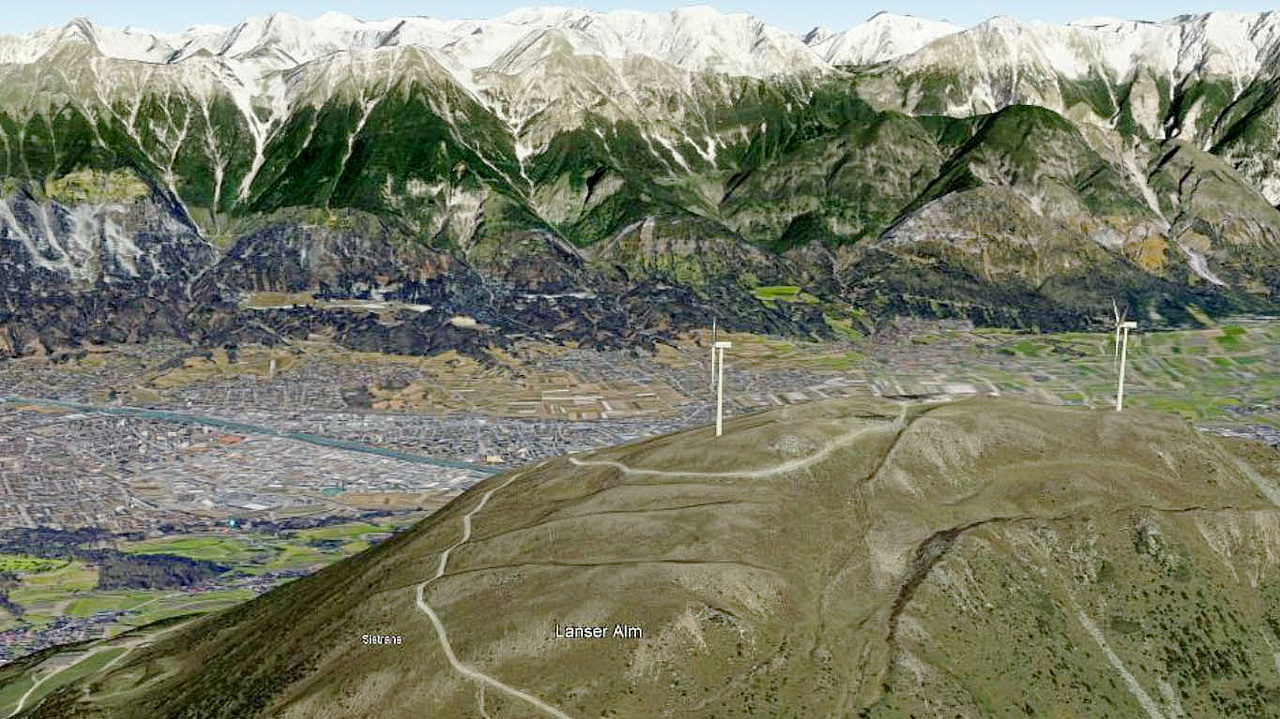
(Rendering: Austrian Chamber of Trade and Industry, Ropeway Section)
Photovoltaics
Photovoltaic systems currently have enormous potential for growth in the generation of renewable energy. For ski area operators, too, there are numerous possible applications for this technology. The main consideration is to ensure that the PV arrays cannot be covered with snow.
Car parks are particularly suitable for high-capacity photovoltaic systems as an added use to what are already sealed land surfaces. A good example exists in the form of a solar folding roof built over a car park in the Appenzell region of Switzerland. On an area of approx. 4,000 sq.m., with space for 152 cars, the system delivers 420 kWp of electricity. Thanks to the innovative folding mechanism of the PV arrays, three to four times more electricity is produced in the snowy winter months compared with fixed panels on which the snow can settle.
An unusual idea implemented in Valais, Switzerland, involves the use of a lake for a floating photovoltaic installation. It comprises a carpet of 36 photovoltaic panels that are anchored to the bottom of the lake and rise and fall with changes in the water level. Upright structures are another option, as in the case of the tower-shaped PV installation by the name of PV-Pappel (Poplar PV), which has been erected on the Gerlitzen in Carinthia, Austria at 1,770 m above sea level. The standard model with 36 panels has a capacity of 15.4 kWp. The structure is 11.3 m high and 3.5 m wide and is inclined at an angle of 70° to prevent snow from settling. The installation is designed to generate ten times more electricity in winter than conventional PV surface systems.
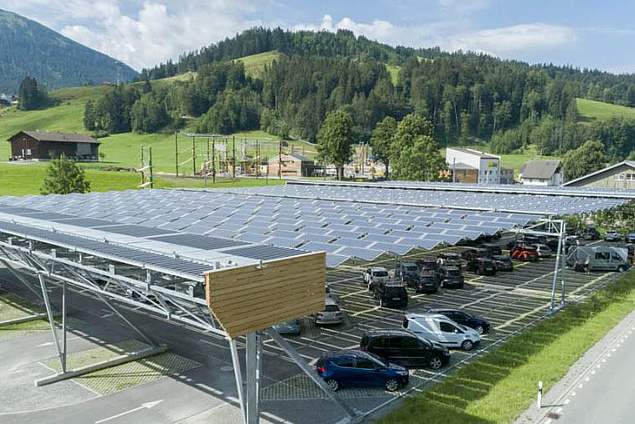
(Photo: Austrian Chamber of Trade and Industry, Ropeway Section)
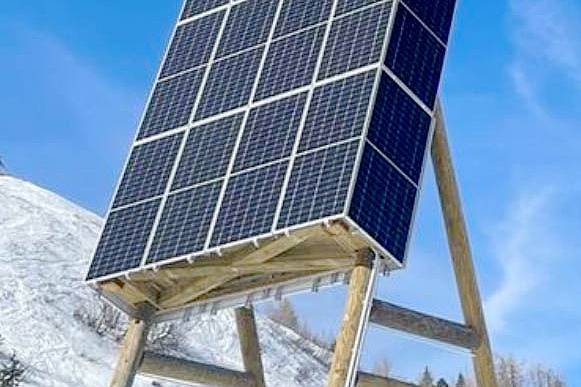
(Photo: Austrian Chamber of Trade and Industry, Ropeway Section)
There is particularly great potential for photovoltaic systems located in the open terrain, with the PV panels installed either on dedicated supports or on existing avalanche protection structures. By way of example, the speakers presented and discussed both implemented systems and a number of proposed projects.

(Photo: ISR archives)
As technical manager at Bergbahnen Kühtai GmbH & Co, Wilhelm Mareiler was naturally very well informed about his company’s own Kühtai PV installation. He gave an enthusiastic report on the development of the project and expectations in terms of generation.
Summary
Both for economic reasons and in the interest of environmental protection, ropeway operators are becoming increasingly active in the construction of renewable energy systems, despite all the difficulties and resistance encountered. The presentations made by Christian Felder and Wilhelm Mareiler show that, in their quest for energy autonomy, ropeways have already taken the first steps from vision to reality.
![[Translate to English:] Foto: Leitner](/fileadmin/_processed_/a/8/csm_Vertragsunterzeichnung_Narvik_6_copyright_LEITNER_print_501f2d5c24.jpg)
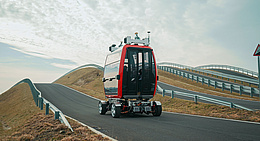
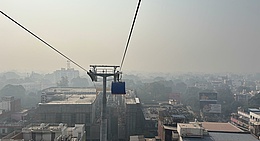
![[Translate to English:] (c) Doppelmayr](/fileadmin/_processed_/b/3/csm_85-ATW_Stechelberg-Muerren_Lauterbrunnen_CHE_001_6442c0520d.jpg)


